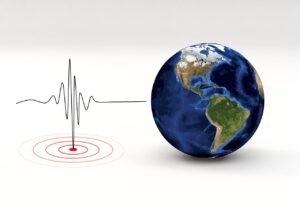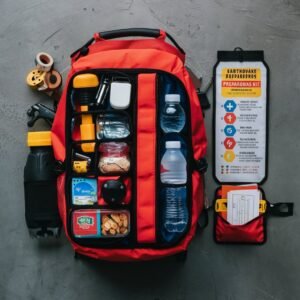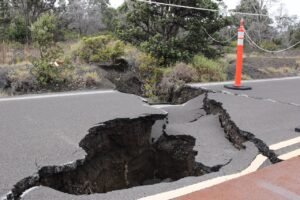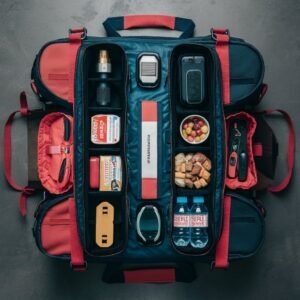I want to tell you about preparing an emergency bag for earthquakes, hope you understand the importance of it. It’s one of those things you never think about until you realize how crucial it is. I will share with you the details you need to know, including how you have to choose the right bags for the Earthquake Preparedness Kit and some suggestions of good types of bags.
It all started a few years ago when I read about the devastating earthquake that hit Nepal in 2015. The 7.8 magnitude quake caused massive destruction and left thousands of people homeless and in desperate need of supplies. The images of people scrambling for food, water, and shelter stayed with me. Then, in 2017, Mexico City was rocked by a 7.1 magnitude earthquake, which brought back memories of the 1985 quake. Both events underscored the importance of being prepared. 
Living in an earthquake-prone area myself, I knew it was time to take action. Here’s how I went about creating my emergency preparedness kit, and hopefully, it can help you do the same.
Your Emergency Preparedness
It’s just 7 steps you take and you are there, yes it’s as simple.
Step 1: Research and List-Making
The first thing I did was research what should go into an emergency kit. The Red Cross and FEMA have great resources, but I also looked into personal accounts from people who had survived earthquakes. The key items everyone mentioned were water, non-perishable food, first aid supplies, and important documents. So, I made a comprehensive list.
Step 2: Assembling the Essentials
I started with water. Experts recommend having at least one gallon of water per person per day for at least three days. I bought several large water containers and made sure they were easy to carry. For food, I opted for canned goods and high-energy snacks like granola bars and dried fruit. Don’t forget a manual can opener!
Step 3: First Aid and Hygiene
A good first aid kit is crucial. Mine includes bandages, antiseptics, pain relievers, and any prescription medications I might need. I also packed some hygiene products—things like wet wipes, hand sanitizer, and a few rolls of toilet paper. Trust me, these can be lifesavers in an emergency. 
Step 4: Tools and Comfort Items
I packed a flashlight with extra batteries, a multi-tool, and a whistle. The whistle is especially useful if you get trapped and need to signal for help. I also added a small radio to stay updated on news and emergency broadcasts. For comfort, I included a blanket, a change of clothes, and some basic toiletries.
Step 5: Important Documents
This one is often overlooked but incredibly important. I made copies of my ID, insurance policies, and important contact numbers. These went into a waterproof pouch to keep them safe.
Step 6: Personalizing the Kit
Everyone’s needs are different. I have a pet, so I packed some extra food and water for my furry friend. If you have kids, you might want to include some toys or comfort items for them.
Step 7: Keeping It Up-to-Date
I realized that my kit isn’t something I can just pack and forget. Every six months, I check the expiration dates on food and medicine and replace items as needed. I also update the documents if there are any changes. 
Lessons Learned from Past Earthquakes
Continuing from my previous note about preparing an emergency kit, I wanted to share some information about significant earthquakes over the past two decades and their impacts. Understanding these events can underscore the importance of being prepared.
1. The 2004 Indian Ocean Earthquake and Tsunami
On December 26, 2004, a 9.1-9.3 magnitude earthquake struck off the west coast of northern Sumatra, Indonesia. This was one of the deadliest natural disasters in recorded history. The earthquake triggered a series of devastating tsunamis along the coasts of most landmasses bordering the Indian Ocean, killing an estimated 230,000-280,000 people in 14 countries, with Indonesia, Sri Lanka, India, and Thailand among the hardest hit.
Impact:
- Massive loss of life and property.
- Long-term economic impacts due to the destruction of infrastructure and livelihoods.
- Significant international humanitarian response and subsequent advancements in global tsunami warning systems.

2. The 2010 Haiti Earthquake
On January 12, 2010, a 7.0 magnitude earthquake struck near the capital of Haiti, Port-au-Prince. The earthquake caused catastrophic damage, particularly because of the poor building standards and densely populated areas.
Impact:
- Estimated death toll between 100,000 and 316,000.
- Over 1.5 million people displaced.
- Severe destruction of infrastructure, including hospitals, schools, and government buildings.
- Massive international aid response, though recovery has been slow and challenging.

3. The 2011 Tōhoku Earthquake and Tsunami
On March 11, 2011, a 9.0 magnitude earthquake occurred off the northeast coast of Japan. It was followed by a massive tsunami that reached heights of up to 40.5 meters (133 feet) in some areas. This disaster also caused the Fukushima Daiichi nuclear disaster.
Impact:
- Approximately 15,899 deaths, with thousands more injured or missing.
- Massive destruction of infrastructure, with entire towns wiped off the map.
- Long-term displacement of residents due to the nuclear contamination zone.
- Significant changes in global nuclear energy policies and safety standards.

4. The 2015 Nepal Earthquake
On April 25, 2015, a 7.8 magnitude earthquake struck Nepal, causing widespread destruction in the Kathmandu Valley and the surrounding region. A major aftershock of 7.3 magnitude hit on May 12, causing further damage and loss of life.
Impact:
- Nearly 9,000 people killed and around 22,000 injured.
- Hundreds of thousands of homes destroyed or damaged.
- Cultural heritage sites, including UNESCO World Heritage sites, severely damaged.
- Long-term economic impacts on a country already struggling with poverty and infrastructure challenges.
5. The 2017 Central Mexico Earthquake
On September 19, 2017, a 7.1 magnitude earthquake struck central Mexico, causing significant damage in Mexico City and surrounding states. This earthquake occurred on the anniversary of the devastating 1985 Mexico City earthquake.
Impact:
- Over 370 people killed and thousands injured.
- Widespread destruction of buildings, including schools and apartment complexes.
- Highlighted the importance of earthquake-resistant construction and effective emergency response systems.
Lessons Learned
These earthquakes have taught us many lessons:
- Preparedness and Education: Public awareness and preparedness can significantly reduce casualties. Countries like Japan have made earthquake drills and education a part of everyday life.
- Building Codes: Strict building codes and enforcement are crucial in reducing the damage and loss of life. Earthquake-resistant construction can make a significant difference.
- Early Warning Systems: Advances in technology have improved early warning systems, giving people precious seconds to take cover.
- Community and International Support: The global response to these disasters highlights the importance of international cooperation and community support in recovery efforts.
Choosing the Right Bag for Your Earthquake Preparedness Kit
Now, let’s talk about the kind of bag you’ll need for your earthquake preparedness kit. The right bag can make all the difference in ensuring your supplies are accessible and protected when you need them most.
1. Durability and Material
First and foremost, you want a bag that’s durable and made from high-quality materials. Look for bags made from heavy-duty nylon or polyester, as these materials are both tough and lightweight. Waterproof or water-resistant materials are ideal since your bag and its contents may be exposed to the elements.
2. Size and Capacity
The size of your bag will depend on how many people you’re preparing for and how comprehensive you want your kit to be. For a family, a large backpack or duffel bag may be necessary. Here are a few options:
- Backpack: A sturdy, large-capacity backpack (50-60 liters) is a great choice because it’s easy to carry and keeps your hands free. Look for one with multiple compartments to organize your supplies.
- Duffel Bag: For larger families or more extensive kits, a duffel bag with wheels can be convenient. It offers plenty of space and can be easily moved around.
- Tactical Bag: These are designed for rugged conditions and often have multiple compartments, MOLLE webbing for additional gear, and are extremely durable.

3. Comfort and Portability
Comfort is crucial because you might need to carry the bag for an extended period. Look for:
- Padded Straps: Adjustable, padded shoulder straps and a padded back panel can make carrying heavy loads more comfortable.
- Waist and Chest Straps: These help distribute the weight more evenly across your body, reducing strain on your shoulders and back.
- Wheels: Some larger duffel bags come with wheels, which can be a lifesaver if you need to transport a lot of supplies over a flat surface.
4. Organization and Accessibility
Being able to quickly access your supplies can be crucial in an emergency. Look for bags with multiple compartments, pockets, and dividers. Some key features to consider:
- External Pockets: These are great for items you might need to access quickly, like flashlights, first aid kits, or water bottles.
- Internal Compartments: These help keep your supplies organized and easy to find. Look for bags with clear or mesh pockets for visibility.
- MOLLE System: If you’re opting for a tactical bag, the Modular Lightweight Load-carrying Equipment (MOLLE) system allows you to attach additional pouches and gear to the outside of your bag.

5. Special Features
Some additional features can add to the functionality of your earthquake preparedness kit bag:
- Hydration Bladder Compartment: If you live in a particularly hot or dry area, a bag with a compartment for a hydration bladder can be very useful.
- Compression Straps: These help reduce the size of your bag and keep everything compact.
- Reflective Strips: These can help you stay visible in low-light conditions, which is crucial in an emergency.
6. Personalization and Specific Needs
Remember, your earthquake preparedness kit should be tailored to your specific needs. If you have a pet, include a small bag or compartment for pet supplies. For families with young children, consider a separate small bag with items specifically for them, like diapers, formula, and toys.
The last two decades have shown us the devastating power of earthquakes and the importance of preparedness. By learning from these events and taking proactive steps, we can mitigate the impacts and improve our resilience to future quakes.
Preparing for an earthquake might seem daunting, but taking it step-by-step makes it manageable. I hope sharing my journey helps you create your own emergency kit. Trust me, the peace of mind you get from knowing you’re prepared is worth it.
Stay safe,

